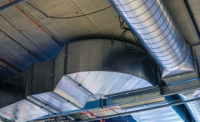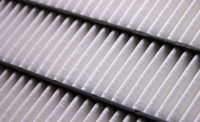Providing adequate ventilation is a very important part of a patient’s wellbeing in a health care setting. Maintaining a high level of indoor air quality (IAQ) has become an increasing challenge for health care facilities. A critical part of ensuring proper IAQ is supplying the appropriate amount of ventilation to replenish oxygen, to remove carbon dioxide, and to reduce the activity of airborne pathogens.
ASHRAE 170, Ventilation of Health Care Facilities was first published in 2008 to address the specific ventilation needs in a health care environment. Prior to 2008, there were no specific standard available to address the minimum ventilation requirement for health care environments. ASHRAE standard 62.1, Ventilation for Acceptable Air Quality, prior to 2010 contained Appendix E, which was specific to health care facilities. This part of the standard no longer exists, and the requirements were completely transferred to ASHRAE 170 when it was issued in 2008. The standard has been incorporated in the Facility Guideline Institute “Guideline for Design and Construction of Health Care Facilities,” since 2010.
It should be noted that this ventilation standard only serves as a minimum requirement and does not prevent a more stringent approach by the city, state, or the federal government. Most ventilation rates for health care facilities are expressed as room air changes per hour (ACH). Peak efficiency for particle removal in the air space occurs between 12 ACH and 15 ACH (Sehulster & Chinn, 2003).
There are more than 100 types of spaces with different use in a health care setting. The standard stipulates a minimum engineering design requirement for each type of these spaces.
ANSI/ASHRAE/ASHE Standard 170-2013, Ventilation of Health Care Facilities, can be adopted in part or as a whole by authorities for health care facility construction and private organizations. In 2010, FGI incorporated Standard 170- 2008 as Part Six of its Guidelines for Design and Construction of Health Care Facilities. This includes all addenda, present and future, issued by ASHRAE. Because the Center of Medicare and Medicaid Services (CMS) no longer adopts design standards (with the exception of the life safety Code), every state will vary in its adoption process of the FGI Guideline 2014. The Joint Commission, federal agencies, and authorities in 44 states use the 2010 guidelines either as a code or a reference standard when reviewing, approving, and financing projects or when surveying, licensing, certifying, or accrediting newly constructed facilities. Some states have written their own standards and use the guideline as a model (e.g., California, Texas). Currently, there are three states that have already adopted the 2014 guidelines: Georgia, Louisiana, and Pennsylvania.
In March 2014, the Facilities Guidelines for Hospitals and Outpatient Facilities issued two separate guidelines; (1) Exclusively for Hospitals and Outpatient facilities and (2) For Residential Health care and Support facilities. The 2013 edition of ANSI/ASHRAE 170 has been incorporated as Part 4 in the FGI Guidelines for Design and Construction of Hospitals and Outpatient Facilities.
There were a number of addenda issued for ASHRAE 170-2008. These addenda to the standard have been published to provide updated requirements to: address committee input and suggestions, improve coordination between the standard and the FGI Guidelines; and reflect determinations from proposed changes and requests for interpretations. These addenda have being incorporated in the new ASHRAE 170-2013.
N.R Definition
N.R as listed in multiple sections of ASHRAE 170 is often defined to be a neutral pressurization with respect to the adjacent spaces. Rooms that have a directional classification of N.R can have either positive or negative classification. For HVAC design purposes, this means that the amount of air that is supplied can exactly match the air that is returned or exhausted. Because of the dynamics of airflow through diffusers, grilles and ducts, it is almost impossible to ensure a neutral pressure condition in a room. The code really means that there is no specific pressure requirement for these spaces.
Energy Recovery
Health care facilities are among the highest energy users in the U.S. According to the 2003 Commercial Building Energy Consumption Survey (CBECS), the average energy use intensity (EUI) is approximately 250 kBtu/sq ft, ranking just behind the food service sector. This means that the energy use of a hospital is just less than three times that of an office building. The use of energy recovery in a health care mechanical system has become necessary to capture energy that would be otherwise wasted.
The provision of energy recovery is now specifically addressed in ASHRAE 170-2013. The standard states that care must be taken to prevent cross contamination of exhaust back into the supply airstream. An airborne isolation room’s exhaust cannot be part of the energy recovery air stream. Runaround coils and heat pipes are two energy recovery methods that fully meet the standard criterion. This change will help health care facilities to reduce the high level of energy use.
Endoscopy Room Pressure Relationship
This room was listed to be positive in the 2008 version of the standard. This room was changed to be “no requirement (N.R)” for directional pressure relationship for the 2013 standard. The Society of Gastroenterology Nurses and Associates (SGNA) and American Society of Gastrointestinal Endoscopy (ASGE) were contacted on the pressure classification, and neither of the organizations express a preference.
However, if the endoscopy room is used for bronchoscopy, then the room will required to be negative pressure with respect to the adjacent spaces.
Duct Lining – Addendum y
The 2013 standard now includes the requirement of an external vapor barrier for insulation that is placed on a cold surface. It also states that a vapor barrier is not required for insulation materials that do not absorb or transmit moisture. This means that when ductwork, pipe, or equipment is insulated, care must be taken to ensure that moisture does not penetrate the insulation material.
The standard also addresses the repair of insulation and ductwork lining that is accessible during renovation. It states that it shall be inspected, repaired, and/or replaced as appropriate. This inclusion is self-explanatory and only serves to ensure that the integrity of the moisture barrier and insulation is maintained for the HVAC system during renovation work.
The use of duct lining is prohibited downstream of the second filter bank for HVAC systems. The prohibited use of duct liner has been associated with the use of fiberglass liners on the interior surfaces of ductwork. Fiberglass has the ability to trap dirt and moisture which, if left at the right conditions, will support mold growth. Fiberglass also degrades over time and often becomes dislodged in the airstream. However, the standard does not addresses the use of Mylar and other impenetrable liners that have excellent resistance to moisture and most chemicals. The standard will need to address the use of these types of liners in the future.
The change in 2013 does allow duct lining with impervious cover in terminal units, sound attenuators, and terminal units downstream of the second filter bank. This is somewhat contradictory because the same method of lining such equipment can be applied to ductwork, but it would still not meet the requirement of the standard.
The standard also precludes the use of duct liner within 15 ft down stream of humidifiers. Once again this make sense if the material has poor resistance to moisture. As mentioned earlier there are duct lining material that are moisture resistant and will not be affected by moisture carryover. Since humidifiers are prone to moisture carryover it is imperative to create a downstream condition that is not susceptible to moisture absorption.
Flue Gases on Package Units – Addendum a
The ASHRAE 170 committee received an unofficial interpretation on whether or not the flues on rooftop package units need to meet the 25 ft clearance from outside air intake on the same units. An equipment vendor conducted and shared an unofficial report that flue gases were undetected at 4 ft from the flue on the rooftop package units. Although more research is needed, the ASHRAE 170 committee voted to exempt rooftop package units from the 25 ft requirements as long as they meet the NFPA 54 requirements (identical to what ASHRAE 62.1 requires).
This ruling will help health care designs to reduce the cost associated with venting of gas rooftop air handling equipment. This modification was submitted for public ruling and is pending final approval.
Exam Room ACH – Addendum ad
The submitted change for this addendum is to reduce the exam room ACH from six and four. This modification in the standard serves to reduce the energy use by health care facilities. The current ASHRAE 2013 standard still has the minimum six total ACH for exam rooms. The ASHRAE 170 committee voted to approve this change, which was based on research that was conducted by the NIH in the late 1990s. The research concluded that six ACH is best but four is acceptable; however, thermal comfort will be the final governing criterion. This really means that the four ACH will have to meet the total cooling and heating load in the exam room or the HVAC load with dictate the ACH. This modification was submitted for public ruling and is pending final approval.
Coordination with new Faculties Guideline 2014 Edition publications – Addendum ae
These items are based on comments received during public reviews in the 2014 Guidelines revision process:
• Delete reference to FGI Guidelines in Paragraph 6.1.2, Heating and Cooling Sources.
• Clarify Paragraph 6.3.2.b that “critical” exhaust must be a minimum of 10 ft from intakes, vs. 25 ft.
• Clarify Paragraph 7.1.1.b to require, rather than suggest, that ventilation rates for spaces not indicated in Table 7-1 be obtained from Standard 62.
• Clarify AII Room and PE Room terminology in Paragraph 7.2.1.e (and 7.7.2.a) – “provide a minimum differential pressure” vs. “limit leakage airflow.”
• Clarify in Paragraph 8.2.b that “sufficient space” for maintenance of equipment is that required by the manufacturer.
• Clarify in Paragraph 8.6 that diffusers for delivery rooms, trauma rooms, wound intensive care rooms, PE rooms, and CCU and ICU rooms be cleaned initially and at regular intervals.
Laboratory Work Areas – Addendum c
The ASHRAE 170-2013 still contains references to laboratories, which is no longer part of the new FGI 2014 publications. The FGI publication now references all laboratories as “Laboratory Work Areas.”
The ACH for the Laboratory Work Areas is now standardized as six ACH. The existing ASHRAE 170-2013 still have some areas listed with 10 ACH. The standard states that higher ventilation rates can be used when dictated by laboratory program requirements and hazard level of potential contaminants in each laboratory areas. The standard also allows a lower ventilation rate than the six ACH under two scenarios: 1) If a risk assessment is done per ANSI/AIHA/ASSE Z9.5 Laboratory Ventilation Standard and it is determined than there is no hazardous contaminants in the Laboratory Work Area, or 2) If a demand control ventilation approach is implemented with active sensing of contaminants as described in the ASHRAE HVAC Applications Handbook on Laboratories.
The standard also went on to talk about the requirement of positive pressure relationship for media transfer laboratory areas. In this case, the pressure relationship between the adjacent areas can no longer be negative.
Operating Rooms
It should be noted that ASHRAE 170 did not modify the classification of operating room types that have being modified in the Hospital and Outpatient Facilities Guideline, 2014 edition. The 2013 edition still has the operating room classification of A, B, and C that was adapted from the American College of Surgeons publication 04GR-001: Guidelines for Optimal Ambulatory Surgical Care and Office-Based Surgery that was published in May of 2000.
The new classification in the Hospital and Outpatient Facilities Guideline, 2014 edition, are based on invasiveness of the procedure being performed during the surgeries; there are only two classifications: 1) operating room and 2) procedure room. There are no longer different levels of operating room A, B and C that still exist in the new ASHRAE 170-2013. This was not included because the time between the publication of the FGI-2014 Guidelines and the ASHRAE 170-2103 was too short to solicit a public vote.
ASHRAE standards follow the American National Standard (ANS) which is a national voluntary consensus, which means that all changes have to go through a public review before any changes can be implemented. Since the ASHRAE 170 standard is a continuously updated document, if approved, there will be an addendum issued as soon as a public review has been completed.
Summary
ASHRAE 170 is a standard that is being continuously maintained. This process of maintenance is managed by the ASHRAE 170 committee. All proposed changes and published addendum are a result of committee member initiatives, proposed changes that arise as a result to new information received, and requests for information from health care designers. The FGI guidelines are reviewed on a four-year cycle, which is very different from the ASHRAE 170 process. ES
References
1. Facilities Guidelines Institute. 2014. Guidelines for Design and Construction of Hospital and Outpatient Facilities
2. Facilities Guidelines Institute. 2010. Guidelines for Design and Construction of Health Care Facilities.
3. AIA. 2006. Guidelines for Design and Construction of Health Care Facilities. American Institute of Architects.
4. Tang, et al. 2006. “Factors involved in the aerosol transmission of infection and control of ventilation in health care premises.” Journal of Hospital Infection 64:100 – 114.
5. Lowen, et al. 2007. “Influenza virus transmission is dependent on relative humidity and temperature.” PLOS Pathogens3(10).
6. Shaman, K. “Absolute humidity modulates influenza survival, transmission, and seasonality.” Proceedings of the National Academy of Sciences.www.pnas.org/cgi/doi/10.1073/pnas.0806852106.
7. Centers for Disease Control and Prevention (CDC) and Health care Infection Control Practices Advisory Committee (HICPAC). 2003. “Guideline for environmental infection control for health care facilities.” www.cdc.gov/hicpac/pdf/guidelines/eic_in_HCF_03.pdf.
8. Bartley, J., L.K. Archibald, F. Memarzadeh, R. Conner. 2010. ASHE/FGI Workshop. “The Role of Humidity in Operating Rooms — Demystifying the Myth.” http://tinyurl.com/4pnkxtj.
Garold “Gary” Hamilton is a principal and the healthcare engineering lead in the D.C. Office for SmithGroupJJR. He is a licensed professional engineer in the United States, as well as in the United Kingdom. He has over 18 years of experience in the design and analysis of HVAC systems for a variety of market sectors, but with special focus on healthcare facilities. He is a LEED AP and has designed over 18 projects that achieved LEED-certified status. Hamilton is also a certified commissioning authority with the AABC Commissioning Group (ACG). He is an active member of ASHE and is an ASHE volunteer with responsibility in assisting ASHE with providing peer support and assisting in special projects. His major clients include Trinity Health/Holy Cross Hospital; Highland Community Hospital; Hattiesburg Clinic, Kaiser Permanente, Unity Healthcare; the NAVFAC, VA Hospitals; and the University of Virginia Health System. Email him at gary.hamilton@smithgroupjjr.com, visit www.smithgroupjjr.com






